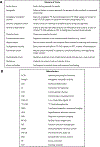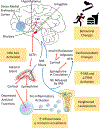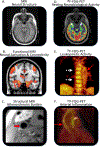Disentangling the Links Between Psychosocial Stress and Cardiovascular Disease
- PMID: 32791843
- PMCID: PMC7430065
- DOI: 10.1161/CIRCIMAGING.120.010931
Disentangling the Links Between Psychosocial Stress and Cardiovascular Disease
Abstract
Stress is a pervasive component of the human experience. While often considered an adversity to be ignored, chronic stress has important pathological consequences, including cardiovascular disease (CVD). Stress also increases the prevalence and severity of several CVD risk factors, including hypertension, diabetes mellitus, and obesity. Yet even after adjustment, stress' attributable CVD risk is similar to those risk factors, suggesting it is a particularly potent contributor. Nevertheless, there has been insufficient study of mechanisms linking stress to CVD or of methods to attenuate stress' pathological impact. This review covers the current concepts of how stress impacts CVD and emerging approaches to mitigate stress-attributable CVD risk.
Keywords: atherosclerosis; cardiovascular diseases; humans; hypertension; psychological distress; risk adjustment; risk factors.
Figures







Similar articles
-
Effects of stress on the development and progression of cardiovascular disease.Nat Rev Cardiol. 2018 Apr;15(4):215-229. doi: 10.1038/nrcardio.2017.189. Epub 2017 Dec 7. Nat Rev Cardiol. 2018. PMID: 29213140 Review.
-
Psychosocial Risk Factors and Cardiovascular Disease and Death in a Population-Based Cohort From 21 Low-, Middle-, and High-Income Countries.JAMA Netw Open. 2021 Dec 1;4(12):e2138920. doi: 10.1001/jamanetworkopen.2021.38920. JAMA Netw Open. 2021. PMID: 34910150 Free PMC article.
-
Psychosocial stressors predict lower cardiovascular disease risk among Mexican-American adults living in a high-risk community: Findings from the Texas City Stress and Health Study.PLoS One. 2021 Oct 7;16(10):e0257940. doi: 10.1371/journal.pone.0257940. eCollection 2021. PLoS One. 2021. PMID: 34618834 Free PMC article.
-
Emotional Stress in Cardiac and Vascular Diseases.Curr Vasc Pharmacol. 2025;23(3):172-195. doi: 10.2174/0115701611328094241104062903. Curr Vasc Pharmacol. 2025. PMID: 39754763 Review.
-
Cardiovascular and autonomic reactivity to psychological stress: Neurophysiological substrates and links to cardiovascular disease.Auton Neurosci. 2017 Nov;207:2-9. doi: 10.1016/j.autneu.2017.03.003. Epub 2017 Mar 16. Auton Neurosci. 2017. PMID: 28391987 Free PMC article. Review.
Cited by
-
Examining relationships between perceived neighborhood social cohesion and ideal cardiovascular health and whether psychosocial stressors modify observed relationships among JHS, MESA, and MASALA participants.BMC Public Health. 2022 Oct 11;22(1):1890. doi: 10.1186/s12889-022-14270-x. BMC Public Health. 2022. PMID: 36221065 Free PMC article.
-
Effects of lifestyle factors on leukocytes in cardiovascular health and disease.Nat Rev Cardiol. 2024 Mar;21(3):157-169. doi: 10.1038/s41569-023-00931-w. Epub 2023 Sep 26. Nat Rev Cardiol. 2024. PMID: 37752350 Review.
-
Risk and impact of stroke across 38 countries and territories of the Americas from 1990 to 2021: a population-based trends analysis from the Global Burden of Disease Study 2021.Lancet Reg Health Am. 2025 Feb 15;43:101017. doi: 10.1016/j.lana.2025.101017. eCollection 2025 Mar. Lancet Reg Health Am. 2025. PMID: 40034838 Free PMC article.
-
Depressive symptoms partially mediate the relationship between psychosocial factors and epigenetic age acceleration in a multi-racial/ethnic sample of older adults.Brain Behav Immun Health. 2025 Apr 12;45:100994. doi: 10.1016/j.bbih.2025.100994. eCollection 2025 May. Brain Behav Immun Health. 2025. PMID: 40291341 Free PMC article.
-
Conversion Therapy Exposure and Elevated Cardiovascular Disease Risk.JAMA Netw Open. 2025 May 1;8(5):e258745. doi: 10.1001/jamanetworkopen.2025.8745. JAMA Netw Open. 2025. PMID: 40327341 Free PMC article.
References
-
- Perk J, De Backer G, Gohlke H, Graham I, Reiner Z, Verschuren M, Albus C, Benlian P, Boysen G, Cifkova R, et al. European Guidelines on cardiovascular disease prevention in clinical practice (version 2012). The Fifth Joint Task Force of the European Society of Cardiology and Other Societies on Cardiovascular Disease Prevention in Clinical Practice (constituted by representatives of nine societies and by invited experts). Eur Heart J. 2012;33:1635–1701 - PubMed
-
- Rosengren A, Hawken S, Ounpuu S, Sliwa K, Zubaid M, Almahmeed WA, Blackett KN, Sitthi-amorn C, Sato H, Yusuf S, et al. Association of psychosocial risk factors with risk of acute myocardial infarction in 11119 cases and 13648 controls from 52 countries (the INTERHEART study): Case-control study. Lancet. 2004;364:953–962 - PubMed
Publication types
MeSH terms
Grants and funding
LinkOut - more resources
Full Text Sources
Medical

